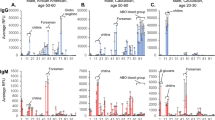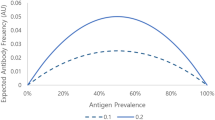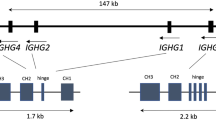Abstract
We have identified the Xga antigen, encoded by the XG blood group gene, by employing rabbit polyclonal and mouse monoclonal antibodies raised against a peptide derived from the N-terminal domain of a candidate gene, referred to earlier as PBDX. In indirect haemagglutination assays, these anti-peptide antibodies react with Xg(a+) but not Xg(a−) erythrocytes. In antibody-specific immobilization of antigen (ASIA) and immunoblot assays, the anti-peptide antibodies react with the same molecule as does human anti-Xga. Therefore, by its identity with PBDX, Xga is identified as a cell-surface protein that is 48% homologous to CD99 (previously designated the 12E7 antigen), the product of MIC2 which is tightly linked to XG. PBDX is renamed here XG.
This is a preview of subscription content, access via your institution
Access options
Subscribe to this journal
Receive 12 print issues and online access
$209.00 per year
only $17.42 per issue
Buy this article
- Purchase on Springer Link
- Instant access to full article PDF
Prices may be subject to local taxes which are calculated during checkout
Similar content being viewed by others
References
Mann, J.D. et al. A sex-linked blood group. Lancet 1, 8–10 (1962).
Race, R.R. & Sanger, R. in Blood groups in man 578–593 (Blackwell Scientific, Oxford, 1975).
Fialkow, P.J., Lisker, R., Giblett, E.R. & Zavala, C. Xg locus: failure to detect inactivation in females with chronic myelocytic leukaemia. Nature 226, 367–368 (1970).
Lawler, S.D. & Sanger, R. Xg blood-groups and clonal-origin theory of chronic myeloid leukemia. Lancet i, 584–585 (1970).
Fialkow, P.J. X-chromosome inactivation and the Xg locus. Am. J. hum. Genet. 22, 460–463 (1970).
Buckton, K.E., Jacobs, P.A., Rae, L.A., Newton, M.S. & Sanger, R. An inherited X-autosome translocation in man. Ann. hum. Genet. 35, 171–178 (1971).
Ferguson-Smith, M.A., Sanger, R., Tippett, P., Aitken, D.A. & Boyd, E. A familial t(X;Y) translocation which assigns the Xg blood group locus to the region Xp22.3→pter. Cytogenet. cell Genet. 32, 273–274 (1982).
Yates, J.R.W. et al. Multipoint linkage analysis of steroid sulfatase (X-linked ichthyosis) and distal Xp markers. Genomics 1,52–59 (1987).
Schlossman, S.F. et al. CD antigens 1993. J. Immunol. 152, 1–2 (1994).
Goodfellow, P.N. & Tippett, P. A human quantitative polymorphism related to Xg blood groups. Nature 288, 404–405 (1981).
Goodfellow, P.J., Pritchard, C., Tippett, P. & Goodfellow, P.N. Recombination between the X and Y chromosomes: implications for the relationship between MIC2, XG, and YG. Ann. hum. Genet. 51, 161–167 (1987).
Tippett, P., Shaw, M.-A., Green, C.A. & Daniels, G.L. The 12E7 red cell quantitative polymorphism: control by the Y-borne locus, Yg. Ann. hum. Genet. 50, 339–347 (1986).
Ellis, N.A. et al. Cloning of PBDX, an MIC2-related gene that spans the pseudoautosomal boundary on chromosome Xp. Nature Genet. 6, 394–400 (1994).
Ellis, N.A. et al. The pseudoautosomal boundary in man is defined by an Alu repeat sequence inserted on the Y chromosome. Nature 337, 81–84 (1989).
Ellis, N. & Goodfellow, P.M. The mammalian pseudoautosomal region. Trends Genet. 5, 406–410 (1989).
Habibi, B., Tippett, P., Lebesnerais, M. & Salmon, C. Protease inactivation of the red cell antigen Xga . Vox Sanguinis 36, 367–368 (1979).
Petty, A. Monoclonal antibody-specific immoblisation of erythrocyteantigens (MAIEA). J. immunol. Meth. 161, 91–95 (1993).
Herron, R. & Smith, G.A. Identification and immunochemical characterization of the human erythrocyte membrane glycoproteins that carry the Xga antigen. Biochem. J. 262, 369–371 (1989).
Banting, G.S., Pym, B. & Goodfellow, P.N. Biochemical analysis of an antigen produced by both human sex chromosomes. EMBO J. 4, 1967–1972 (1985).
Buckle, V., Mondello, C., Darling, S., Craig, I.W. & Goodfellow, P.N. Homologous expressed genes in the human sex chromosome pairing region. Nature 317, 739–741 (1985).
Darling, S.M., Banting, G.S., Pym, B., Wolfe, J. & Goodfellow, P.N. Cloning an expressed gene shared by the human sex chromosomes. Proc. natn. Acad. Sci. U.S.A. 83, 135–139 (1986).
Fellous, M., Bengtsson, B., Finnegan, D. & Bodmer, W.F. Expression of the Xg(a) antigen on cells in culture and its segregation in somatic cell hybrids. Ann. hum. Genet. 37, 421–430 (1974).
Campana, T., Szabo, P., Piomelli, S. & Siniscalco, M., The Xga antigen on red cells and fibroblasts. Cytogenet Cell Genet. 22, 524–526 (1978).
Hsu, S.H., Migeon, B.R. & Bias, W.B. Unreliability of the microcomplement fixation method for Xga typing of cultured fibroblasts. Birth Defects 12,382–386 (1976).
Ellis, N. et al. Population structure of the human pseudoautsomal boundary. Nature 344, 663–665 (1990).
Banting, G.S., Pym, B., Darling, S.M. & Goodfellow, P.N. The MIC2 gene product: Epitope mapping and structural prediction analysis define an integral membrane protein. Molec. Immunol. 26, 181–188 (1989).
Smith, M.J., Goodfellow, P.J. & Goodfellow, P.N. The genomic organisation of the human pseudoautosomal gene MIC2 and the detection of a related locus. Hum. molec. Genet. 2, 417–422 (1993).
Levy, R., Dilley, J., Fox, R.I. & Wamke, R. A human thymus-leukemia antigen defined by hybridoma monoclonal antibodies. Proc. natn. Acad. Sci U.S.A. 76, 6552–6556 (1979).
Gelin, C. et al. The E2 antigen, a 32 kd glycoprotein involved in T-cell adhesion processes, is the MIC2 gene product. EMBO J. 8, 3253–3259 (1989).
Aubrit, F., Gelin, C., Pham, D., Raynal, B. & Bernard, A. The biochemical characterization of E2, a T cell surface molecule involved in rosettes. Eur. J. Immunol. 19, 1431–1436 (1989).
Bodger, M.P. Isolation of hemopoietic progenitor cells from human umbilical cord blood. Expt. Hematol. 15, 869–876 (1987).
Dworzak, M.N. et al. Flow cytometric assessment of human MIC2 expression in bone marrow, thymus, and peipheral blood. Blood 83, 415–425 (1994).
Ambros, I.M. et al. MIC2 is a specific marker for Ewing's sarcoma and periferal primitive neuroectodermal tumors. Cancer 67,1886–1893 (1991).
Kovar, H. et al. Overexpression of the pseudoautosomal gene MIC2 in Ewing's sarcoma and peripheral primitive neuroectodermal tumor. Oncogene 5, 1067–1070 (1990).
Harlow, E. & Lane, D., A Laboratory Manual.(Cold Spring Harbor Laboratory Press, New York 1988).
Green, N. et al. Immunogenic structure of the influenza virus hemagglutinin. Cell 28, 477–487 (1982).
Kohler, G. & Milstein, C. Continuous cultures of fused cells secreting antibody of predefined specificity. Nature 256, 495–497 (1975).
Shulman, M., Wilde, C.D. & Kohler, G. A better cell line for making hybridomas secreting specific antibodies. Nature 276, 269–270 (1978).
Goodfellow, P.N., Pritchard, C. & Banting, G.S. in Genome analysis: a practical approach (ed. Davies, K.E.) 1–18 (IRL Press, Oxford, 1988).
Mallinson, G. et al. Identification and partial characterization of the human erythrocyte membrane components) that express the antigens of the LW blood-group system. Biochem. J. 234, 649–652 (1986).
Ausubel, F. et al. (ed.) Current protocols in molecular biology (Green Publishing Associates and Wiley-lnterscience, New York, 1993).
Clepet, C. et al The human SPY transcript. Hum. molec. Genet. 2, 2007–2012. (1993).
Author information
Authors and Affiliations
Rights and permissions
About this article
Cite this article
Ellis, N., Tippett, P., Petty, A. et al. PBDX is the XG blood group gene. Nat Genet 8, 285–290 (1994). https://doi.org/10.1038/ng1194-285
Received:
Accepted:
Issue Date:
DOI: https://doi.org/10.1038/ng1194-285
This article is cited by
-
Clofarabine inhibits Ewing sarcoma growth through a novel molecular mechanism involving direct binding to CD99
Oncogene (2018)
-
CD99 at the crossroads of physiology and pathology
Journal of Cell Communication and Signaling (2018)
-
Tackling the characterization of canine chromosomal breakpoints with an integrated in-situ/in-silico approach: The canine PAR and PAB
Chromosome Research (2008)
-
CD99 plays a major role in the migration of monocytes through endothelial junctions
Nature Immunology (2002)
-
Characterization of the promoter region of human steriod sulfatase: A gene which escapes X inactivation
Somatic Cell and Molecular Genetics (1996)



